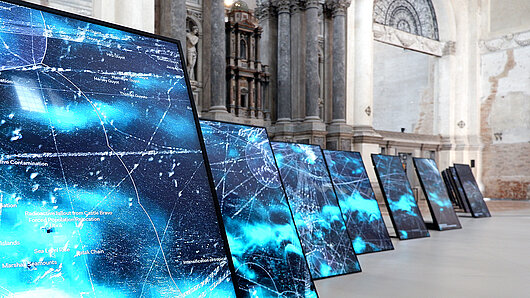High-Performance Computing Center Stuttgart

EIT Culture & Creativity is an EU-wide Knowledge and Innovation Community (KIC) that was announced by the European Institute of Innovation & Technology (EIT) in June 2022. It is one of nine European KIC’s designed to promote the development of products, services, companies, and training opportunities that support European economic development in strategically important fields. EIT CC aims to strengthen and transform Europe’s cultural and creative sectors and industries by connecting creatives and organizations to Europe’s largest innovation network.
The Media Solution Center Baden-Württemberg — co-founded by HLRS in 2018 to facilitate collaboration among artists, cultural institutions, and experts in high-performance computing — is a co-founder and lead partner in EIT Culture & Creativity, and also co-chairs a Germany-wide consortium called Innovation by Creative Economy (ICE), one of 50 partners participating in EIT CC. In this way, HLRS is the only high-performance computing (HPC) center involved in EIT Culture & Creativity, and aims to lead in the development of models that will enable artists and cultural organizations to take advantage of the opportunities that HPC, artificial intelligence (AI), high-performance data analytics, and other digital technologies could offer. As co-chair of ICE, the Media Solution Center also aims to help promote the state of Baden-Württemberg as a center for the culture industry in Europe.
MSC General Manager Matthias Hauser says that HLRS’s involvement in EIT Culture & Creativity is an affirmation of its early recognition of the many opportunities that collaboration between the creative industries and high-performance computing centers could offer. “Together with EIT, we want to network the know-how that exists at HLRS with that found at supercomputing centers across Europe,” he says. “Conferences like the one held at HLRS are important to articulate how collaboration between the culture and creative industries and science could best function. The support that HLRS provides is helping the culture and creative community to gain a better understanding of what is possible.”
In addition to the plenary sessions, the meeting at HLRS also featured two keynote talks to frame the stakes within which Europe’s cultural and creative industries are operating.
In the first lecture, engineer and fine arts scholar Marcos Cuzziol of the University of São Paulo offered a nontechnical introduction to machine learning, and surveyed recent applications of artificial intelligence in popular media. He also discussed recent artworks that have used AI to raise critical questions about the relationship between machine intelligence and human perception, agency, and creativity. In the question and answer period following the lecture, Cuzziol and conference attendees discussed several open questions regarding the ethics and aesthetics of using artificial intelligence in art.
Focusing on the effects of human life and industry on the systems that sustain life on Earth, John Palmesino of the multidisciplinary independent organization Territorial Agency argued that the arts must address the increasingly urgent challenges the planet faces, including climate change, pollution, and consumption of natural resources. He suggested that creatives are unique in their ability to create experiences and narratives that can help people to better understand the complex factors that are driving such changes, and to motivate efforts to address them. He presented several examples of his agency’s work, which have brought together scientists, artists, policy specialists, media designers, and others to research ways of representing changes in the ocean, impacts of the oil industry, and influences of human activity in the Anthropocene.
In parallel to their work with the EIT, the MSC and HLRS have partnered with the Barcelona Supercomputing Center to take part in the S+T+ARTS AIR program, an EU-wide artist residency program that supports collaboration between artists, scientists, and technology experts. For the first time, artists will be able to access the technology and expertise at two of Europe’s leading supercomputing centers. An open call for proposals recently closed and winners of the residencies will be announced in November.
The Media Solution Center was also involved in the development of the exhibit Renaissance 3.0, which is on view at the Center for Art & Media (ZKM) in Karlsruhe until January 7, 2024. Curated by Peter Weibel, the exhibition explores new alliances between artists, scientists, and engineers based on a set of shared tools, including computing technologies. After closing at the ZKM, the show will travel to Paris and Budapest.
— Christopher Williams